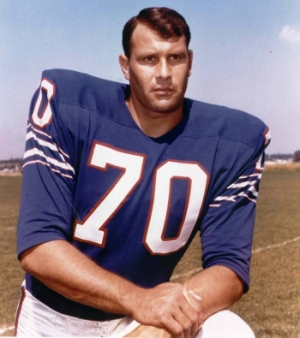Ex-McNeese standout Sestak
a forgotten legend
|
|
|||||
|
|
|
|
|
||
| . | |||||
| . |
|
Tom Sestak |
| . |
|
|
|
|
January 31, 2012
|
|
He had the most
decorated
professional
career of any
football player
in McNeese State
history.
In the 1960s, the only two defensive linemen to earn more unanimous All-Pro selections were Hall of Famers Bob Lilly and Merlin Olsen. Those who were named unanimous All-Pro an equal number of times are also enshrined in Canton: Willie Davis, Gino Marchetti and Deacon Jones. He was the third player inducted to the Buffalo Bills Wall of Fame, behind O.J. Simpson and Jack Kemp. Yet Tom Sestak is not a household name. He’s not in the Louisiana Sports Hall of Fame, and his collegiate number — 88 — hasn’t been retired by McNeese. Somehow, one of the largest men to step on a football field in his era has slipped under the radar. With a half-century passed since the last time he wore a Cowboy uniform, the number of people who remember Sestak’s play is starting to dwindle. Now is the time to remind everyone else what they missed.
Even before he made it big, “Big” was the first word used to describe Sestak. Old American Press articles sometimes refer to him as “Big Tom” on second reference rather than by his last name. After all, who else could they be talking about? At 6 feet 5 inches and a muscular 240 pounds, he was a hard figure to miss. “The first days, he looked like a mountain out there to me,” said McNeese teammate Ted Brevelle. “I remember he had the biggest calves and the biggest legs I had ever seen.” Huey Simoneaux was a freshman in 1960, the year Sestak joined the squad as a junior transfer. As a defensive end and offensive tackle, Simoneaux was no midget. Yet even he was awed by Sestak at first sight. “When Tom came in before our first practice, I thought he was one of the coaches, he was so big,” Simoneaux said. “Then we started putting on the uniforms and I said, ‘Lord have mercy, that’s not a coach.’ ” Big Tom only got bigger. When he arrived at Bills training camp as a rookie, the very man who drafted him could barely recognize the 270-pounder walking into the team hotel. “As the rookies came in every year, the cabs dropped them off and they’d check in,” recalled Larry Felser, a Buffalo newspaper reporter who covered the Bills from 1960 to 2001. “I was sitting there one evening and this guy gets out of the cab, and the guy would make Superman look like a ballet dancer. It was Sestak. “Harvey Johnson, the chief scout, was sitting next to me and I said ‘Who the hell is this guy?’ “He says, ‘I drafted him, but I don’t remember who he is.’ Then he says, ‘My God, that’s Sestak, the tight end from McNeese State.’ ”
••••
Sestak’s rise from McNeese to the top of the American Football League was an unlikely journey for a 17th-round draft pick. Then again, so was coming to McNeese. A native of Gonzales, Texas, Sestak was originally recruited out of high school by Bear Bryant at Texas A&M. But after it was revealed that boosters were offering Sestak money to sign with the Aggies, he ended up at Baylor for two years before quitting school and joining the Army. Following that two-year stint, Sestak decided to finish up his education and ended up at McNeese because that’s where his brother went to school. It didn’t take long for him to become a dominant force against the competition in the Gulf States Conference. “He was a great defensive player,” Brevelle said. “He would literally close that side of the field down for running. He couldn’t hardly be blocked.” Brevelle, a halfback, had the misfortune of attempting to block Sestak in more than one practice. “Blocking him every day in practice was a task. I hated to see those drills come around,” Brevelle said. “You couldn’t get into his legs like a lot of defensive ends. You couldn’t get there on him.” Simoneaux said going up against Sestak in practice made him a better lineman. “Nobody was spared. He was (6-foot-5), 270 pounds without an inch of fat,” Simoneaux said. “He had arms like an octopus. Plus he’d hit you. Back then you used forearms and shoulder blocking. He was tough. He’d get in that hole — to block him you had to hit him below the knee.” And as Brevelle found out, doing that didn’t come without repercussions. “I remember one time in practice I got in on his knee to block him and he literally picked me up and said, ‘Stay off my knee,’ ” Brevelle said. Most interactions with Sestak weren’t as unpleasant for his teammates. “As big and tough and mean as he could have been, he wasn’t bad,” Simoneaux said. “Now, you didn’t want to get on his bad side. But he was a great guy. Easygoing, anything goes.” For the most part, Big Tom was the guy teammates wanted to hang out with after games or at any other time. “We had a good rapport,” Simoneaux chuckled. “He could drink some whiskey.”
••••
After his college career wrapped up in 1961, the Bills decided they couldn’t pass up on someone with Sestak’s size despite not knowing exactly what they wanted to do with him. All college players in the era played both offense and defense, and Buffalo listed Sestak as a tight end when it picked him— though as Brevelle recalls, Sestak’s receiving skills weren’t otherworldly. “I didn’t remember him being much on offense with catching the ball, but the (widespread) passing of the ball was just coming into the game,” Brevelle said. What he did have was unbelievable speed for someone of his stature. “In the offseason we would get out and run and try to stay in shape, and he was hard to keep up with on a 30-40-yard sprint,”Brevelle said. “I’m sure that led to him getting to the pros. It didn’t surprise me that he got in.” In the days before Mel Kiper turned draft analysis into its own industry, finding a player from a school as small as McNeese was a rarity. Sestak was only the third Cowboy to ever make it to the professional ranks after capturing the attention of Johnson, the Bills’ head scout, through a tip. “(Johnson) was accustomed to going down there (scouting) for players in the CFL,” Felser said. “He made a lot of contacts in the Gulf States. Harvey’s old connection was with Jack White, the old head scout of the 49ers. Jack had seen Sestak play tight end and told him ‘This guy is built like a statue.’ ” It was Bills coach Lou Saban who decided the only thing Sestak should be doing is attacking ballcarriers. Saban matched Sestak up against guard Billy Shaw in camp, and that matchup continued in practices for the rest of the decade. “Saban said, ‘You’re either going to beat the hell out of each other and be out of football, or you’ll be the best linemen in pro football,” Felser recalled. Shaw was inducted into the Hall of Fame in 1999. He is the only AFL player in Canton who played his entire career before the league merged with the NFL in 1971.
••••
With Sestak anchoring the middle of the Bills’ line, Buffalo built one of the most dominant defenses of the era. In a remarkable run, the Bills went 17 straight games without allowing a rushing touchdown in 1964-65. Buffalo won the AFL title both years. “I don’t think so,” former Bills trainer Eddie Abramoski said when asked if that would have been possible without Sestak.“He was a dominant player. If you ever needed a stop or a sack, Tom got it when you needed it.” Of course, the number of sacks Sestak recorded is a mystery since it did not become an official statistic until 1982. But those who saw him play knew his impact. Sestak’s old roommate on the Bills, Paul Maguire, is one of them. Maguire, who was a punter and reserve linebacker for Buffalo, went on to work as a color commentator for NBC and ABC broadcasts in the four decades after his retirement. “I don’t know if the Bills have ever had a better defensive tackle,” Maguire said. In 1965, when arguing the merits of the AFL versus the NFL, Jets owner Sonny Werblin used Sestak as his primary example of why the upstart league could compete with the traditional one, saying Sestak was “as good a football player as there is in the country.” Maguire feels the Bills defense would have stacked up against the NFL’s best teams in either of those years, but the first Super Bowl was not played until after the 1966 season. So why isn’t there a bust of Sestak in Canton? Certainly the bias against a player who spent his entire career in the AFL may be a factor. “A lot of times guys get passed over because it was the American Football League and not the NFL,” Maguire said. But the biggest factor working against Sestak was his health. Though he was arguably the most dominant defensive tackle in football from 1963 to 1965, poor knees prevented that dominance from carrying over the course of more seasons. In his last two seasons, Sestak couldn’t even practice because of his injuries. “He was probably the toughest player in my 37 years as a trainer for the Bills,” Abramoski said. “He just was outstanding. He always wanted to be on the field. The last two years he just rode the exercise bike and played the games.” Maguire said Sestak’s playing status was perpetually in question during the 1967 and ’68 seasons, even if his teammates always knew what the answer would be. “He could sit out the entire week, and as long as he played Sunday we never cared,” Maguire said. “He’d walk into the locker room Sunday, you’d ask him if he was playing and he gave you that (expletive) grin.” Maguire said no one thought of going on the injured reserve in the days when owners held all the cards. “The reason people talk about him so much — he played injured, yes — is that those guys didn’t miss games,” Maguire said.“The same guys week in and week out lined up and played. “Unless they ripped your (gosh darn) leg off, you played or else they’ll find someone else to take your job. They said,‘Can you play?’ and the answer was an emphatic ‘Hell yes.’ That’s just the way those guys played. Those guys were so good because they knew what each other would do the whole time.” Sore knees were not the only thing Sestak played through. “You hear all these things about concussions,” Abramoski said. “We were playing one time at Polo Grounds, and he was snoring like a guy in his sleep (after a hit). When he came to, we checked him out. The next day we asked, ‘How you feeling?’ ‘I feel good.’ “We held him out all that week and then he played that game.” Such was Sestak’s respect among his teammates that they made sure to include him in postgame celebrations when he was too hurt to leave the training tub. “We’d get a case of beer and bring the bar to him while he’d get iced down,” Maguire said. Most feel that if modern arthroscopic techniques were around then, Sestak would have had the career longevity to be in the Hall of Fame. “They’ve made leaps and bounds in that part of it,” Abramoski said. “We were fortunate in that our team doctor was a head of orthopedics in the Army in the North Atlantic in World War II. He was at the Battle of the Bulge. He was a very good doctor. But there’s been big (advances) now. In the old days a guy would tear his ACL and they would call it a trick knee. “I always thought he should be in the Hall of Fame but never got the recognition. But here in Buffalo, he’s revered.”
•••• After his playing career was over, Sestak stayed in Buffalo, where he owned a couple of bars and restaurants along with Maguire— the first of which, Maguire noted, was purchased at the end of one night while they were drinking there. “The first time I knew how much money he made is when we filled out a financial report to buy the bar, and I was his roommate all those years,” Maguire said. “Nowadays everyone knows how much money everyone in the league makes.” The restaurants did well — which ultimately led to their demise. “We had to give it up. We didn’t realize you had to pay taxes,” Maguire said. “We thought that was for people with paychecks.” Sestak died of a heart attack in 1987 — ironically, Maguire says, just one week after being diagnosed with Lou Gehrig’s disease. Perhaps the fact he isn’t around any more is another reason Sestak’s name isn’t brought up as much as his exploits seem to dictate. But for those who lived and played football during his time, Tom Sestak will never be forgotten. “He was absolutely superb,” Maguire said. “But the best way anybody can describe him was a great friend to all of us. The first time I ever met him, in training camp in ’64, he damn near broke my hand when I shook it. You knew you had a friend, from the first time I met the guy. And it never changed. He was that kind of guy. Not one bad thing was said about this guy by anyone, ever. And if they did, they sure as hell never said it to his face.” |
|
Above, Alex Hickey states "the biggest factor working against
Sestak was his health", and that his short career is why Hall of Fame
selectors ignore him. But Paul Maguire said it best: “A lot of times
guys get passed over because it was the American Football League and not
the NFL.” There are several players already in the Hall of Fame who played seven years or less ~ Gayle Sayers being the most notable. Sestak is a member of the All-Time American Football League Team. During the sixties, only six defensive linemen were unanimous All-League selections for three or more years. Sestak was one of them. The other five have already been inducted into the Pro Football Hall of Fame. The reason he has not been selected is that when he became eligible in 1974, the Hall's selectors still held bias against the AFL. It took years for the media to recognize that the AFL was the equal of the NFL. No one would dream of saying that Gayle Sayers didn't play long enough, yet they said that about Sestak. The NFL/AFL ratio in the hall's selectors at that time was 16/10. Selectors rom NFL cities bosted they had never watched an AFL game! If they had, they might have recognized Sestak's greatness. ~ REMEMBER the AFL |
|
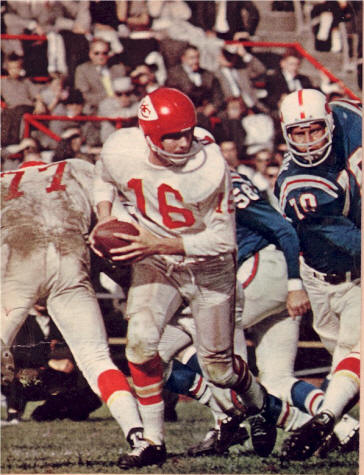 |
|
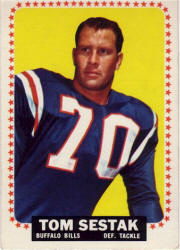 |
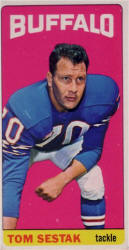 |
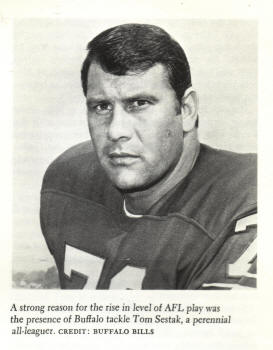 |
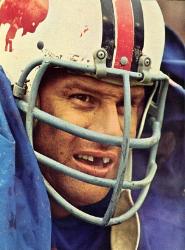 |
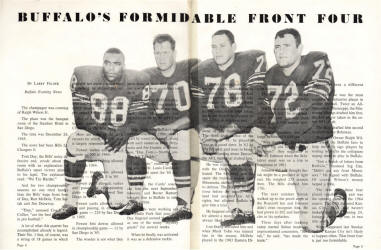 |
| Patriots | Bills | Oilers | Jets | Dolphins | Broncos | Chiefs | Chargers | Raiders | Bengals |
